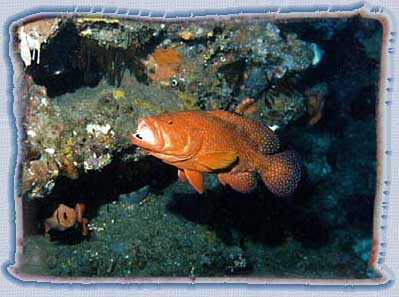IDENTIFYING FEATURES
COLOUR, SHAPE AND SIZE |
This small and very elongate fish
is strikingly coloured. In adults the front half of the body is grey or brownish-white,
while the rear is bright blue. The entire body is marked on each flank by a long, broad,
black band which begins at the snout, passes through the eye and, towards the tail,
becomes progressively wider. A black band also marks the dorsal surface from head to tail.
Juvenile bluestreak cleaner wrasse are similarly marked, but lack the whitish grey that
mantles the fore-parts, the entire body being a bright blue or black. |
| EXTERNAL ANATOMY |
The single lateral line curves
abruptly downwards towards the tail, and along its length fine, adherent scales are
arranged in 50-52 series, however, a magnifying glass may be necessary to count them. The
fins are well developed, and include a single dorsal of nine spines plus 1 1 rays, an anal
of three spines plus ten rays, and a square caudal that is barely distinguishable from the
body. The small mouth is located at the tip of the pointed snout, and is surrounded by
thick lips, the lower of which is split in two. Each jaw bears a patch of small canines as
well as a band of finer teeth. The first gill arch has 7-10 short rakers |
| NATURAL HISTORY |
A common and extremely active
little reef fish, the bluestreak cleaner wrasse has a most remarkable lifestyle. It
depends for its food on the ectoparasites and mucus covering other, larger fish. Any such
fish wishing to rid its body of ectoparasites which it itself is unable to remove will
passively submit to a complete and thorough scouring by the cleaner wrasse. The 'client'
fish often also opens its mouth and gill covers to allow the wrasse to continue its work.
Yet even more remarkable than this habit, is the species' territorial behaviour. it
actually sets up cleaning stations which are voluntarily visited by parasite infested fish
which occasionally even 'queue' for their turn. Each cleaning station is 'manned' by a
single male and his attendant harem. Should the male die, or be removed, within half an
hour the dominant female will begin to display aggressive behaviour, and within 2-4 days
the process of sex reversal is complete. Sometimes the male from a neighbouring station
may invade the harem, and, if sufficiently aggressive, may succeed in 'overthrowing' the
resident male, thereby incorporating that harem into his own. This inherent ability to
control the production of males within a species also occurs in the sea goldie. Mimicry is
well known in the animal kingdom, and there is a small blenny (Aspidontes taeniatus) which
closely resembles the cleaner wrasse. Its intentions, however, are very different, for
instead of removing ectoparasites, it uses its relatively large fangs to tear chunks of
flesh from the unsuspecting host! Obviously, aquarists must identity these fish correctly. |


